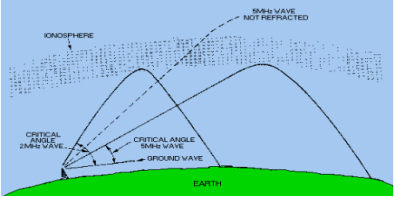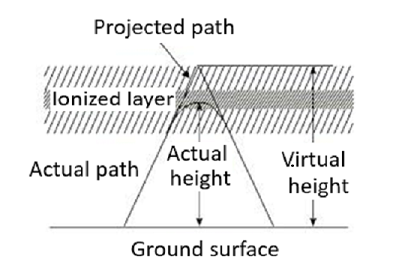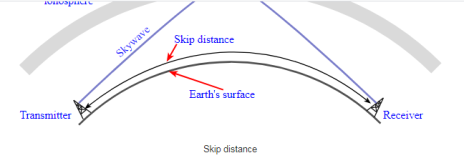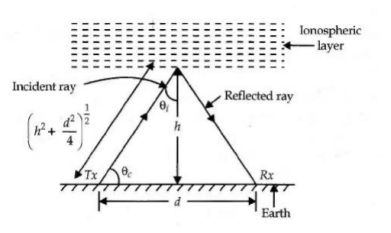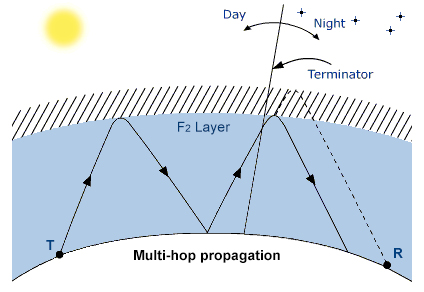|
● The D layer is the innermost layer, 60 km (37 mi) to 90 km (56 mi) above the surface of the Earth. Ionization here is due to Lyman series-alpha hydrogen radiation at a wavelength of nanometre (nm) ionizing nitric oxide (NO).
● In addition, high solar activity can generate hard X-rays (wavelength < 1 nm) that ionize N2 and O2. Recombination rates are high in the D layer, so there are many more neutral air molecules than ions.
● Medium frequency (MF) and lower high frequency (HF) radio waves are significantly attenuated within the D layer, as the passing radio waves cause electrons to move, which then collide with the neutral molecules, giving up their energy.
● Lower frequencies experience greater absorption because they move the electrons farther, leading to greater chance of collisions. This is the main reason for absorption of HF radio waves, particularly at 10 MHz and below, with progressively less absorption at higher frequencies.
● This effect peaks around noon and is reduced at night due to a decrease in the D layer's thickness; only a small part remains due to cosmic rays. A common example of the D layer in action is the disappearance of distant AM broadcast band stations in the daytime.
● During solar proton events, ionization can reach unusually high levels in the D-region over high and polar latitudes. Such very rare events are known as Polar Cap Absorption (or PCA) events, because the increased ionization significantly enhances the absorption of radio signals passing through the region.
E layer● The E layer is the middle layer, 90 km (56 mi) to 150 km (93 mi) above the surface of the Earth.
● Ionization is due to soft X-ray (1–10 nm) and far ultraviolet (UV) solar radiation ionization of molecular oxygen (O2). Normally, at oblique incidence, this layer can only reflect radio waves having frequencies lower than about 10 MHz and may contribute a bit to absorption on frequencies above.
● However, during intense sporadic E events, the Es layer can reflect frequencies up to 50 MHz and higher. The vertical structure of the E layer is primarily determined by the competing effects of ionization and recombination.
● At night the E layer weakens because the primary source of ionization is no longer present. After sunset an increase in the height of the E layer maximum increases the range to which radio waves can travel by reflection from the layer.
● The Es layer (sporadic E-layer) is characterized by small, thin clouds of intense ionization, which can support reflection of radio waves, rarely up to 225 MHz.
F layer● The F layer or region, also known as the Appleton–Barnett layer, extends from about 150 km (93 mi) to more than 500 km (310 mi) above the surface of Earth.
● It is the layer with the highest electron density, which implies signals penetrating this layer will escape into space. Electron production is dominated by extreme ultraviolet (UV, 10–100 nm) radiation ionizing atomic oxygen. T
● he F layer consists of one layer (F2) at night, but during the day, a secondary peak (labelled F1) often forms in the electron density profile. Because the F2 layer remains by day and night, it is responsible for most skywave propagation of radio waves and long-distance high frequency (HF, or shortwave) radio communications.
Q.2 Explain in detail Ionospheric Wave Propagation Mechanism.Ans-
|
|
|
|
 Where,fc: critical frequency in HzNmax: maximum electron density per m34. The mathematical representation of critical frequency as a function of MUF is:
Where,fc: critical frequency in HzNmax: maximum electron density per m34. The mathematical representation of critical frequency as a function of MUF is:  Where,fc: critical frequency in HzMUF: maximum usable frequencyӨ: angle of incidence5. Critical frequency varies depending upon atmospheric conditions, time of the day and the angle of fire of the radio waves by the antenna.Q.7 Explain Maximum Usable Frequency (MUF) in sky wave propagation.Ans- 1, When a signal is transmitted using HF propagation, over a given path there is a maximum frequency that can be used. This results from the fact that as the signal frequency increases it will pass through more layers and eventually travelling into outer space. 2. As it passes through one layer it may be that communication is lost because the signal then propagates over a greater distance than is required. Also when the signal passes through all the layers communication will be lost.3. The frequency at which radio communications just starts to fail is known as the Maximum Usable Frequency (MUF). As a rule of thumb it is generally three (for the F region) to five (for the E region) times the critical and it is true for low angles of incidence, although more exact methods are available for determining this figure.4. It is possible to calculate the relationship more exactly:
Where,fc: critical frequency in HzMUF: maximum usable frequencyӨ: angle of incidence5. Critical frequency varies depending upon atmospheric conditions, time of the day and the angle of fire of the radio waves by the antenna.Q.7 Explain Maximum Usable Frequency (MUF) in sky wave propagation.Ans- 1, When a signal is transmitted using HF propagation, over a given path there is a maximum frequency that can be used. This results from the fact that as the signal frequency increases it will pass through more layers and eventually travelling into outer space. 2. As it passes through one layer it may be that communication is lost because the signal then propagates over a greater distance than is required. Also when the signal passes through all the layers communication will be lost.3. The frequency at which radio communications just starts to fail is known as the Maximum Usable Frequency (MUF). As a rule of thumb it is generally three (for the F region) to five (for the E region) times the critical and it is true for low angles of incidence, although more exact methods are available for determining this figure.4. It is possible to calculate the relationship more exactly: Where:
Where:MUF = Maximum Usable Frequency
CF = critical frequency
θ = the angle of incidence.5. The factor sec θ is called the MUF factor and it is a function of the path length if the height layer is known.6. This is the maximum usable frequency, MUF that would permit acceptable operation of a radio service between given terminals under specific working conditions. 7. This form of MUF has the emphasis on the operational acceptability of the circuit. It means that factors such as the antenna, power levels and such like are considered and gives an indication regarding the possibility of real communication at a given station.Q.8 what is mean by Lowest Usable Frequency (LUF) in sky wave propagation, explain it.Ans- 1. As the frequency of a transmission is reduced further reflections from the ionosphere may be needed, and the losses from the D layer increase. These two effects mean that there is a frequency below which radio communications between two stations will be lost. In fact the 2. “Lowest Usable Frequency (LUF) is defined as the frequency at below which the signal falls below the minimum strength required for satisfactory reception.”3. From this it can be seen that the LUF is dependent upon the stations at either end of the path. Their antennas, receivers, transmitter powers, the level of noise in the vicinity, and so forth all affect the LUF. The type of modulation used also has an effect, because some types of modulation can be copied at lower strengths than others.4. In other words the LUF is the practical limit below which communication cannot be maintained between two particular radio communications stations.5. If it is necessary to use a frequency below the LUF then as a rough guide a gain of 10dB must be made to decrease the LUF by 2 MHz. This can be achieved by methods including increasing the transmitter powers, improving the antennas, etc.6. It is found that the LUF actually increases in periods of high solar activity. This is a rising because of the increased levels of solar radiation that give rise to higher levels of ionisation in the D layer. 7. His in turn increases the level of attenuation introduced by this layer. This means that at the peak of the sunspot cycle there is degradation in the performance of the low frequency bands for long distance communications.Q.9 Explain virtual height of sky wave propagationAns- 1. When a wave is refracted, it is bent down gradually, but not sharply. However, the path of incident wave and reflected wave are same if it is reflected from a surface located at a greater height of this layer. Such a greater height is termed as virtual height.
|
 Where,DSKIP: skip distanceh: height at which reflection happensfMUF: maximum usable frequencyfc: critical frequency
Where,DSKIP: skip distanceh: height at which reflection happensfMUF: maximum usable frequencyfc: critical frequency
|
|
 Sin
Sin  =
=  Sin
Sin 1 =
1 =  Sin
Sin  ……
…… Sink ● The condition for the wave to return to earth is to have total internal reflection (TIR), which begins when the refracted angle, θr is 900. ● If this happens at the k th layer,
Sink ● The condition for the wave to return to earth is to have total internal reflection (TIR), which begins when the refracted angle, θr is 900. ● If this happens at the k th layer,  Sin
Sin  =
=  Sin 900 =
Sin 900 =  ● And since,
● And since,  Sin
Sin  =
=  ● Sin2
● Sin2 =
=  =
= 
 =
=  2. Critical frequencyFor a given angle of incidence θi and frequency f, the minimum electron density required to achieve TIR is
2. Critical frequencyFor a given angle of incidence θi and frequency f, the minimum electron density required to achieve TIR is Sin2
Sin2 = 1-
= 1-  ● Where, N is the electron density (m-3),
● Where, N is the electron density (m-3), is the mass of electron at rest,
is the mass of electron at rest,  =9.109
=9.109 kgw is the angular frequency of the wave, w = 2Пf
kgw is the angular frequency of the wave, w = 2Пf is the magnitude of electron charge,
is the magnitude of electron charge,  = 1.6021
= 1.6021  C
C is the permittivity of free space.
is the permittivity of free space.  F/m● If the maximium electron density present is Nmax, refraction of the wave at normal incidence (θi=0 & sinθi = 0), the only possible way for the wave to be totally internally reflected is if ε= 0. ● This requires the frequency to be less than the critical frequency f c , given by
F/m● If the maximium electron density present is Nmax, refraction of the wave at normal incidence (θi=0 & sinθi = 0), the only possible way for the wave to be totally internally reflected is if ε= 0. ● This requires the frequency to be less than the critical frequency f c , given by = Sin2
= Sin2 = 1-
= 1-  = 1-
= 1-  If
If  = 0,
= 0,  = 1
= 1 = 9
= 9 Refractive index as the function of frequency
Refractive index as the function of frequency  = 1 -
= 1 -  = 1 -
= 1 -  = 1 -
= 1 - 
 = 1 –
= 1 –  ,
,
 3. For MUF ,
3. For MUF , =900,
=900,  =
=  where 900= 1
where 900= 1 = 1- sin2
= 1- sin2 = cos2
= cos2
 =
=  =
= 
 =
=  = 9
= 9
 This value of
This value of  is called the maximum usable frequency, and is less than 40 MHz, and can be as low as 25-30 MHz4. Skip distance
is called the maximum usable frequency, and is less than 40 MHz, and can be as low as 25-30 MHz4. Skip distance
|
 =
=  Cos
Cos  =
= 
 =
= 
 =
=  = =(
= =(  =
= 

 + 1
+ 1 =
= 
 =
=  , h =
, h =
 , d=
, d=  ,
, = 2h
= 2h h is the height of the layer d is the skip distance on the flat Earth’s surface.( Key takeaways :Critical frequency is
h is the height of the layer d is the skip distance on the flat Earth’s surface.( Key takeaways :Critical frequency is  = 9
= 9
 =
=  = 9
= 9
 ,
,  = 2h
= 2h )Q.12 Write a note on Multi hop propagation.Ans-
)Q.12 Write a note on Multi hop propagation.Ans- 


